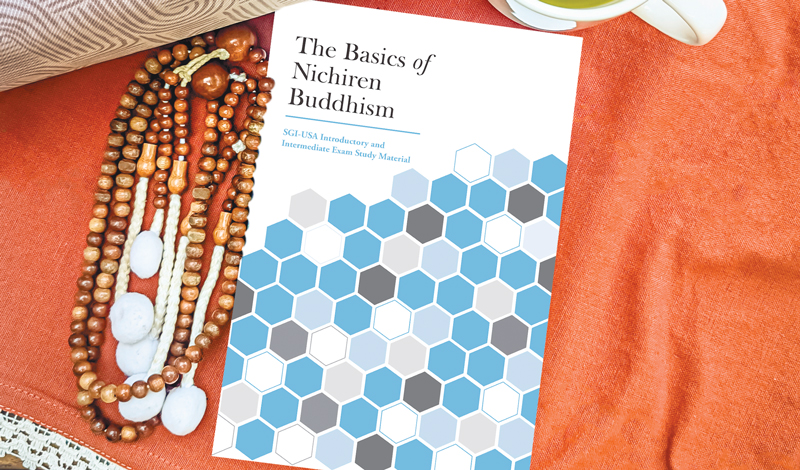These questions were taken from The Basics of Nichiren Buddhism SGI-USA Introductory Exam study guide.
1) What vow did Nichiren Daishonin make as a youth while studying at Seicho-ji temple? (See The Basics of Nichiren Buddhism, p. 3)
a) to become the wisest person in all of Japan to lead his parents and all people to happiness
b) to become the wealthiest person in all of Japan so he could feed all the hungry
c) to become the most highly regarded Buddhist priest in all of Japan so he could reside at Mount Hiei
2) In triumphing over the Tatsunokuchi Persecution, Nichiren, while remaining an ordinary human being, revealed his original identity as a Buddha possessing infinite wisdom and compassion. This is called _________________________ in Buddhism. Please choose the answer that fills in the blank. (See The Basics, p. 9)
a) human transformation
b) winter always turns to spring
c) casting off the transient and revealing the true
3) The Record of the Orally Transmitted Teachings states: “Great joy [is what] one experiences when one understands for the first time that one’s mind from the very beginning has been _______. Nam-myoho-renge-kyo is the greatest of all joys.” Please choose the word that fills in the blank. (See The Basics, p. 21)
a) clouded
b) a Buddha
c) transient
4) Of the Ten Worlds, which world is characterized by an obsession with personal superiority and a tendency to constantly compare oneself with others? (See The Basics, p. 40)
a) the world of asuras
b) the world of animality
c) the world of learning
5) Concerning the Ten Worlds, what is the aim of Buddhist practice? (See The Basics, p. 43)
a) to become the most powerful ruler in the nation
b) to transcend the six paths and develop a self-determined state of happiness that is not controlled by external circumstances
c) to find a serene location in order to enter the state of nirvana
6) What are the three proofs? (See The Basics, p. 49)
a) definite, doubtful and vague
b) soft, medium and hard
c) documentary, theoretical and actual
7) According to the text, without Buddhist study, what are we are at the risk of? (See The Basics, p. 57)
a) lapsing into our own personal interpretations of Buddhism
b) losing all interest in spiritual practice
c) gaining instant enlightenment without effort
8) Nichiren explains that slandering or disparaging the Lotus Sutra is the most fundamental negative cause a person can make. What does it mean to slander the Lotus Sutra? (See The Basics, p. 69)
a) to read the Lotus Sutra without full concentration and insight
b) to practice Buddhism without chanting aloud
c) disparaging or denying the true potential and dignity of human beings
9) What are heavenly gods and benevolent deities in Buddhism? (See The Basics, p. 76)
a) various workings and functions that serve to protect a person who practices the correct Buddhist teaching.
b) angels who appear in human form to guide lost travelers
c) mythical beings who grant wishes to those who pray to them
10) What did the Nichiren Shoshu priesthood do in June 1943 that constituted complicity in slander of the Law (slander of the correct Buddhist teaching)? (See The Basics, pp. 88–89)
a) In response to government pressure and in fear of repression, the priesthood asked the Soka Gakkai to accept the Shinto talisman.
b) The priesthood took concrete measures to prove that the Lotus Sutra was no longer relevant to the lives of the people in these modern times.
c) The priesthood started preaching the superiority of the Flower Garland Sutra.
11) While in prison, in addition to exerting himself in chanting Nam-myoho-renge-kyo, Josei Toda from early 1944 began to read the Lotus Sutra and pondered it deeply. In the process, he experienced two awakenings. What were they? (See The Basics, p. 90)
a) He discovered a hidden code in the Lotus Sutra and that helped him predict future events.
b) He realized that he needed to abandon chanting and decided to pursue a solitary life of meditation.
c) He realized that the Buddha is life itself and that he himself was a Bodhisattva of the Earth.
12) When did Josei Toda become the second Soka Gakkai president, and what did he resolve to do on that occasion? (See The Basics, p. 95)
a) He became president in 1945 and resolved to keep the Soka Gakkai a small, private organization.
b) He took leadership in 1955 and focused solely on writing commentaries on the Lotus Sutra.
c) He became president in 1951 and declared his vow to achieve a membership of 750,000 households.
13) Daisaku Ikeda was inaugurated third Soka Gakkai president on May 3, 1960. What did he do just five months later on October 2? (See The Basics, p. 99)
a) He announced his resignation to focus on writing books about Buddhism.
b) He traveled to North and South America, the first step in a journey to spread Nichiren Buddhism around the world.
c) He established a new Buddhist sect separate from the Soka Gakkai.
14) In 1965, Ikeda Sensei began writing the novel The Human Revolution, which would eventually extend to 12 volumes. His purpose in doing so was to correctly transmit the history and spirit of the Soka Gakkai to future generations. As described in its preface, what is the main theme of the novel? (See The Basics, p. 99)
a) A great human revolution in just a single individual will help achieve a change in the destiny of a nation and, further, will enable a change in the destiny of all humankind.
b) More than philosophical or economic progress, technological advancements are the key to human happiness.
c) Only monks, nuns and priests can fully attain enlightenment due to their withdrawal from secular life and complete dedication to Buddhist practice.
15) On Nov. 28, 1991, the Soka Gakkai achieved its _________________________________ from the Nichiren Shoshu priesthood. Please choose the answer that fills in the blank. (See The Basics, p. 129)
a) goal of kosen-rufu
b) priestly status
c) spiritual independence
Click here to access study material. Register for the exam by April 6, 2025, through your SGI-USA member resources account at portal.sgi-usa.org.
Answers: 1. A; 2. C; 3. B; 4. A; 5. B; 6. C; 7. A; 8. C; 9. A; 10. A; 11. C; 12. C; 13. B; 14. A; 15. C
You are reading {{ meterCount }} of {{ meterMax }} free premium articles

